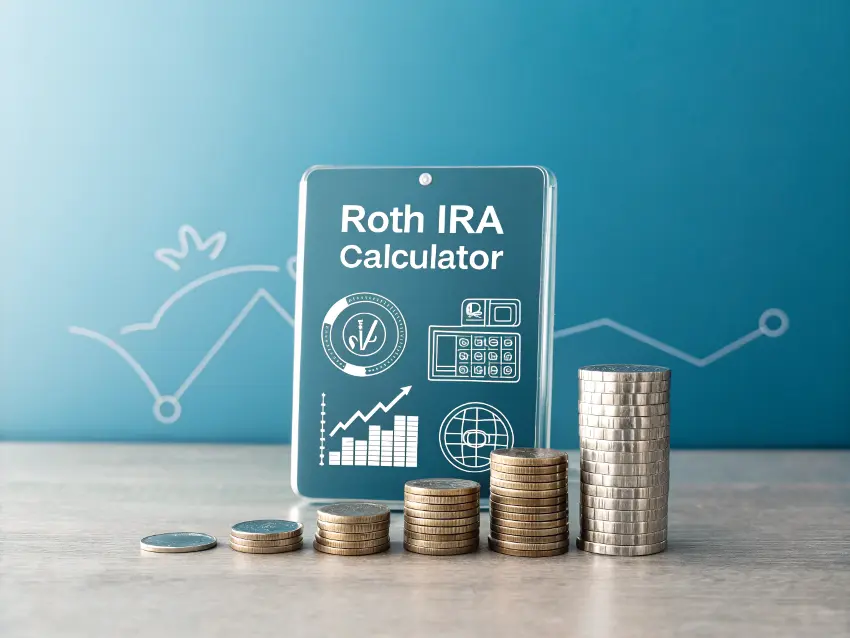Roth IRA Calculator
Calculate your Roth IRA growth and tax advantages

Roth IRA
How Roth IRAs Work:
A Roth IRA is a retirement savings account that offers tax-free growth and tax-free withdrawals in retirement.
Tax Advantages: Unlike Traditional IRAs, Roth IRA contributions are made with after-tax dollars (no tax deduction), but qualified withdrawals in retirement are completely tax-free, including all earnings.
No Required Minimum Distributions: Roth IRAs are not subject to required minimum distributions (RMDs) during the owner's lifetime.
Annual Contribution Limits (2023): $6,500 for individuals under 50, and an additional $1,000 "catch-up" contribution for those 50 and older.
Roth vs. Traditional IRA:
| Feature | Roth IRA | Traditional IRA |
|---|---|---|
| Contributions | After-tax (not deductible) | Pre-tax (may be deductible) |
| Growth | Tax-free | Tax-deferred |
| Withdrawals | Tax-free (if qualified) | Taxed as income |
| RMDs | Not required | Required at age 73 |
| Income Limits | Yes, phase-out based on income | No (deduction may be limited) |
| Best for | Those who expect higher tax rate in retirement | Those who expect lower tax rate in retirement |
Roth IRA Benefits
- Tax-Free Growth: All investment growth is completely tax-free
- Tax-Free Withdrawals: Qualified withdrawals are completely tax-free
- No RMDs: No required minimum distributions during your lifetime
- Flexible Access: Original contributions can be withdrawn at any time tax and penalty-free
- Estate Planning: Excellent wealth transfer tool for heirs
Calculate Your Roth IRA Growth
Current Information
$
$
Max: $6,500.00 (no catch-up contribution)
Investment & Tax Settings
%
Typical range: 5-9% (historical average)
%
Historical average: 2-3%
%
Used for comparison with Traditional IRA
%
Used for comparison with Traditional IRA
Roth IRA Growth Projection
Balance at Retirement:
$0.00
In 0 years at age 65
Inflation-Adjusted Balance:
$0.00
In today's purchasing power
Total Contributions:
$0.00
Tax-Free Interest Earned:
$0.00
Current Tax Cost vs. Traditional:
$0.00
Additional taxes paid now (vs. Traditional IRA)
Tax-Free Withdrawal Value:
$0.00
100% tax-free in retirement
Projected Monthly Income:
$0.00
Using the 4% withdrawal rule
Roth IRA Balance Growth Over Time
Roth IRA FAQs
What is a Roth IRA?
A Roth IRA is a tax-advantaged retirement account where you contribute after-tax dollars, but all growth and qualified withdrawals are completely tax-free. This contrasts with Traditional IRAs, where you may get a tax deduction now but pay taxes on withdrawals later.
Who can contribute to a Roth IRA?
Anyone with earned income can contribute to a Roth IRA, but there are income limits. For 2023, single filers with modified adjusted gross income (MAGI) below $138,000 can make a full contribution, with a phase-out range up to $153,000. For married filing jointly, the full contribution limit applies to MAGI below $218,000, with a phase-out up to $228,000.
How much can I contribute to a Roth IRA?
For 2023, you can contribute up to $6,500 to a Roth IRA, or $7,500 if you're age 50 or older (due to the $1,000 catch-up contribution). Your contribution cannot exceed your taxable earned income for the year, and may be reduced or eliminated at higher income levels.
What are the withdrawal rules for a Roth IRA?
You can withdraw your original contributions from a Roth IRA at any time without taxes or penalties. For earnings, qualified withdrawals are tax-free if the account has been open for at least 5 years and you're either age 59½ or older, disabled, using up to $10,000 for a first-time home purchase, or a beneficiary of a deceased account owner. Non-qualified withdrawals of earnings may be subject to income tax and a 10% early withdrawal penalty.
Roth vs. Traditional: Which is better?
The choice depends on your current and expected future tax situation. A Roth IRA is generally better if you expect your tax rate to be higher in retirement than it is now, while a Traditional IRA might be better if you expect your tax rate to be lower in retirement. Many financial advisors recommend having both types of accounts for tax diversification. Roth IRAs also offer additional benefits like no required minimum distributions during your lifetime and tax-free inheritance for your beneficiaries.
Can I convert my Traditional IRA to a Roth IRA?
Yes, you can convert a Traditional IRA to a Roth IRA through a process called a Roth conversion. You'll need to pay income tax on the converted amount in the year of conversion. There are no income limits for Roth conversions, making this a strategy that even high-income earners can use to fund a Roth IRA (sometimes called a "backdoor Roth IRA").